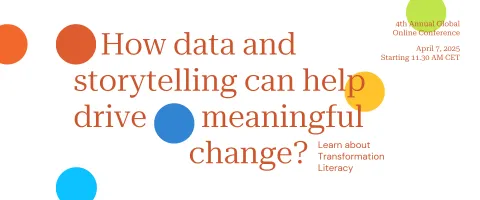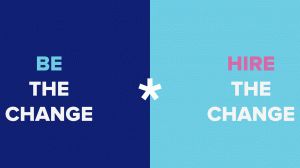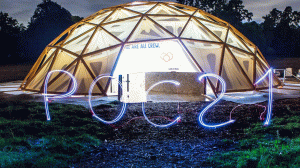Why is polarization spreading all over the place? What does this have to do with the sustainable development movement? And how can narratives and metrics help to achieve sustainability? This article offers perspectives on how the big picture of global Sustainable Development Goals is connected to everyday experience we currently face gives an introduction to two strategies that help to achieve transformative change. And it invites you to learn more during the upcoming Transformation Literacy Conference.
I am sure sustainability matters to you, and you are searching for best practices to make sustainable change happen. However, in these days with Trump and other “old white men” in the news it might feel hard to continue and you might be challenged even by colleagues, friends, family when you hear that the whole sustainability thing needs to pause when other things are more important. Or sustainability even becomes irrelevant. Doubting the importance of sustainability challenges such as climate change, loss of biodiversity, inequalities, or extractive economic systems is what Trump and Co. want. The larger the gap between what is needed for people and planet and what is done, the more arguments they will have for feeding their polarization campaigns.
If giving up on the sustainability agenda and accepting that we live in divided societies is not an option for you, here is a quick reminder: in 2015 the nations of the world agreed on the Sustainable Development Goals (SDGs). For the first time in human history, we have a global agenda and framework that helps us to identify the main sustainability challenges, seeing how these challenges are interlinked, and setting ambitions goals to overcome the challenges. With all the shortcomings these goals might have, especially with the timing that they should be achieved by 2030, they are a great framework for individuals, organisations, and countries to move towards more sustainability. However, that we are not further advanced in achieving the goals might have two crucial reasons: there are too little narratives out there that showcase the successes of sustainable development. Rather, there are many narratives telling us where sustainability fails. And up to today, there have been no proper metrics for some of the goals and the Gross Domestic Product (GDP) remains the most powerful number in the world.
© United Nations (https://www.un.org/sustainabledevelopment) The content of this publication has not been approved by the United Nations and does not reflect the views of the United Nations or its officials or Member States.
Let’s take a closer look at the narratives first: when have you heard the last news about a country achieving climate-neutrality or making good progress towards it? Do you know any society where inequality is decreasing? Is there any completely circular product you bought recently? Most likely it is really hard to say yes to all these questions. It is much easier to find information about countries that do not meet their climate targets, about societies that where inequality is growing, and to buy products that are meant to become waste sooner or later. The old publisher’s wisdom bad news is good news remains true, especially in the age of global “social” media platforms. Asking the important question for whom this is good news – the reader or the provider of the news platform – might give you a proper answer in which direction we should look to improve things. This is not against critical quality journalism which is essential for every democracy as being the fourth power – and which is by the way very often a not very profitable business for news platforms. This to say that if we could add more stories of success instead of failure to news production and consumption, if we add at least to every failure alternatives on how things can be better, we can place ourselves in a mode to find sustainable solutions collectively and train our narrative muscles to become enlivening rather than just waiting for the next catastrophe.
And this is where the second ingredient metrics comes in. If we keep on doing things in the same frames as we have done them before and if we keep on tracking the same goals and numbers, positive change won’t come. Whereas the narratives help us to move the frame a bit that we can see things clearer and from diverse perspectives, life-enhancing instead of life-denying metrics will pave us the way for achieving transformative change. Because what gets measured gets fixed. Why is GDP still the most powerful number in the world? Because it was the best available number at the time when it was invented almost one hundred years aga, it is relatively easy to measure, and it is taught in every economics class. There are many alternative metrics now that overcome the extractive nature of GDP, but one of the main reasons why they are not successful yet is that they are – unlike GDP when it was introduced – not (yet) part of national or even international policymaking. The same goes to the SDGs: all nations agreed to them, but they are not legally binding. For some goals there are not even indicators or proper goal setting in place. While you can hardly influence policymaking at that level, you can check your personal metrics towards a sustainable lifestyle: with CO2 calculators and apps you can check your ecological footprint and change it for better, you can scan the products you buy for their sustainable production, or you can hold your local or national decisionmakers accountable for implementing metrics that matter by telling success stories where this proved to bring positive transformations.
If you are interested to learn more on how life-enhancing metrics relate to enlivening narratives, or if you want to dive deeper into one of these aspects and how they contribute to sustainable development together with international experts, Collective Leadership Institute’s Transformation Literacy Conference on 7 April is the right place to be for you. Each online session will kick-off with a framing by CLI, continues with two international speakers from different continents, and then offers time for exchange with these experts. There is also the opportunity to connect with fellow participants before or after the conference.
You can learn more about the conference sessions, the speakers, and register here: https://www.collectiveleadership.de/blog/event/tlc/.
© Collective Leadership Institute
About the Collective Leadership Institute: CLI’s vision is to empower future-oriented people to lead collectively towards a sustainable future. With our Capacity Building Programmes, our Transformation Support, our Collective Leadership Hubs Network, and our Research, we build competence for sustainability. The institute has been operating since 2005 and has offices in Germany and South Africa, and branch offices in Egypt, Spain, Ukraine, and the United States.










